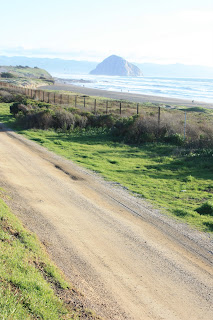

I birded on Saturday from my home in coastal Los Osos to the north coast of the county, with several stops in Cambria (about 25 miles north) and farther north. This was necessary to get some of the species that were only up in the north coastal part of San Luis Obispo county and to step up my mileage for some multi-day trips coming up.
On my usual morning dog walk/bird I heard the song (that spirals up in pitch) of a Purple Finch (#1) - a species that had eluded me so far for the year. Since the tide was very high, I next climbed on my bike and pedalled to the Morro Bay State Park Marina to search for 2 Nelson's Sparrows that had been seen there . On the way, I briefly checked the ducks pushed up against South Bay Boulevard by the incoming tide and picked out the bright rusty head and gray sides of a male Eurasian Wigeon in amongst the large flocks of wigeon, pintail, Green-winged Teal and Mallard. Some of the marina peninsula's main attractions were not as cooperative. Two Large-billed Savannah Sparrows (likely future split?) that had been chased out of the Salicornia (pickleweed) by the tide were easily spotted, but the 2 Nelson's that I was really after were not. After about an hour and a half, I decided that I had to head north on my bike - before the onshore wind from the northwest kicked up into my face and because it was already 10:00.
I had about 20 miles to get to my next "planned" stop. (With bicycle birding you never know when you might want to stop to see something you heard or saw while pedalling (and you can stop almost anywhere.) I went straight up the highway, rather than taking side routes, so I could make good time. I did stop at the overlook of the lagoon at Santa Rosa Creek Mouth, just off Moonstone Drive in Cambria, to check a flock of several hundred gulls, but found nothing unusual (before two unleashed dogs chased them off). My next planned stop was an ocean viewing deck near the northernmost pullout on Moonstone Drive. A birder friend of mine, Maggie, had found 2 Marbled Murrelets here the day before. The surf was high and the birds were out far - not a good combination for finding small alcids. Fortunately, I had brought my large Zeiss scope; I often leave it at home for bike trips, but not when I knew I'd be scoping offshore for species. It came in handy as I spotted 2 pairs of Marbled Murrelets (relatively tiny bird with a small bill, short neck, black cap, white stripes on the black back and white underparts)out well beyond the waves (Bigby # 2) at about the time I was ready to give up looking. With one target species down, I felt the ride was already worth it.
I then headed up to San Simeon Beach where I was skunked for target birds - no bittern, no mergansers, and no Snowy Plovers! Two Brant (pictured) at the creek mouth here seemed out of place. I headed north for my next stop, but decided to ride past it with a lone rider from France who was heading north, until I got to my northernmost destination - the fields of the Hearst Ranch north of San Simeon. There I said goodbye to him and scoped the grassy pasureland for raptors and geese, without any luck. I turned around and stopped at the San Simeon pier, which was quiet bird wise. Little Pico Creek had a fair number of birds off shore, and I picked out another pair of Marbleds Murrelets and one male Black Scoter (BIGBY #3)in among the several rafts of scoters - not great looks, but enough to ID the birds.
Farther south, I took a detour on Cambria Pines Road and took a loop through the Monterey pine/live oak forest for the usual birds of this area - Pygmy Nuthatch (Bigby #4), Hairy Woodpecker, Acorn Woodpecker, Brown Creeper, Townsend's Warbler, Steller's Jay, etc. I enjoy birding here, but I had to be quick because it was after 2:00 PM and I still had 25 miles to get home. I had also covered 52 miles already and I was starting to feel the hills. I did start to feel a good wind at my back, which was a real help.
I only stopped three times on the way home from the pine forest - once to watch an adult Golden Eagle (BIGBY #5) soar effortlessly over my head near Highways 46 and 1. Next, I paused to take the scenery photo herein posted. Last I bought a cookie (tasty fresh oatmeal raisin) and milk at Brown Butter Cookie Company in Cayucos - to help fuel me home. Not that I hadn't already had a fair amount of food on the trip (I have learned that you need to eat a lot on long cycling trips!). on this trip I had eaten a large whole wheat cinnamon roll, orange juice, ham sandwich, egg salad sandwich, blended banana and chocolate milk, power bar, 20 oz. of Gatorade, carton of juice, cashews, and a lot of water. The cookie got me home (at about 4:30) and feeling alright, but I will admit that the hills near home were harder than usual! The 77 miles on this trip made it feel like occasionally birding on a bike trip, rather than biking between birding spots. However, a mostly sunny day and the bright green fields and hills made the ride memorable (oh, and the birds too!).
























